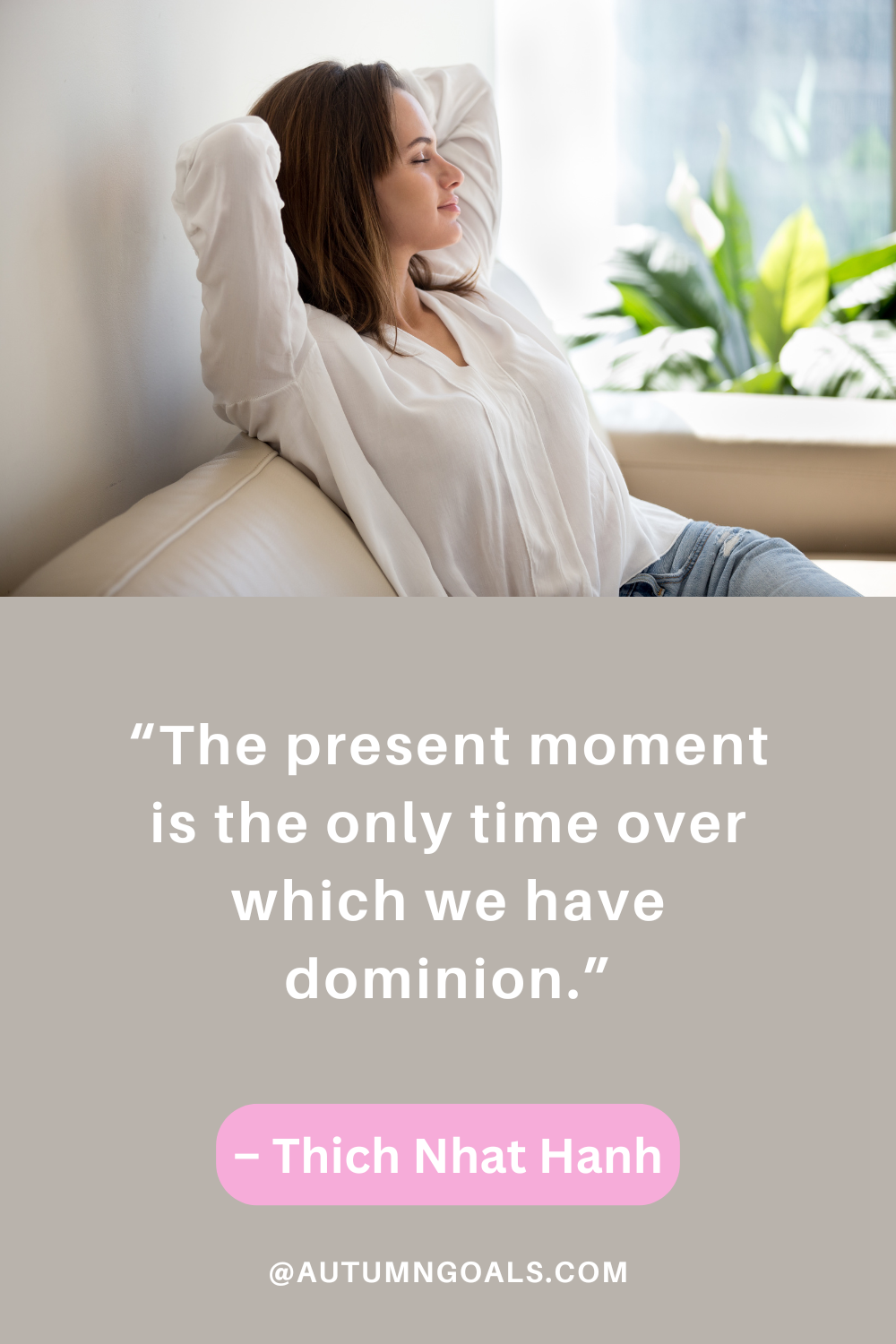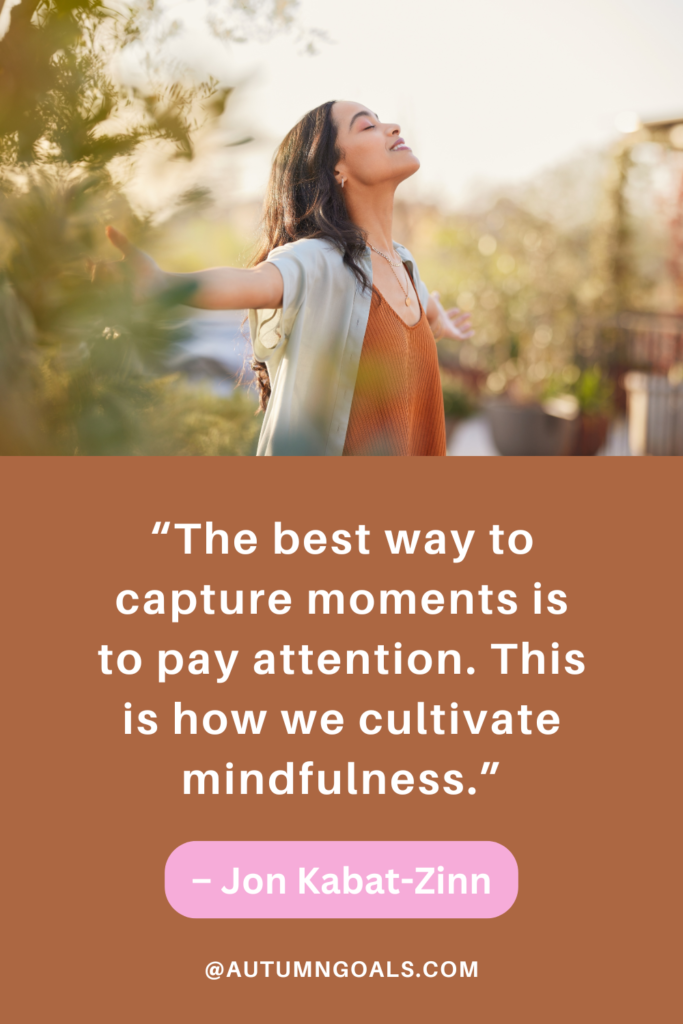Mindfulness in Daily Life: How to Find Inner Peace Amidst Chaos
June 11, 2024 | by autumngoals.com

Mindfulness Photo by Chelsea Gates on Unsplash
Understanding Mindfulness
It’s easy to feel overwhelmed by the chaos of daily life in our fast-paced, ever-changing world. With endless to-do lists, constant digital distractions, and the pressure to always be on the go, finding a moment of peace can seem like an impossible task. This is where mindfulness comes into play. Mindfulness is the practice of being fully present and engaged in the current moment, without judgment. It involves paying attention to our thoughts, feelings, and sensations, allowing us to experience life more deeply and authentically.
Jon Kabat-Zinn, a pioneer in bringing mindfulness to the West, defines it as “paying attention in a particular way: on purpose, in the present moment, and non-judgmentally.”
By cultivating mindfulness, we can develop a greater sense of inner peace, clarity, and well-being, regardless of the external circumstances. This article explores various techniques to incorporate mindfulness into your daily life, providing practical steps to find tranquillity amidst the chaos.
What is Mindfulness?
Mindfulness is more than just a buzzword; it’s a way of living that enhances our ability to focus, reduces stress, and improves overall quality of life. At its core, mindfulness is about being present. It involves noticing what’s happening around us and within us without trying to change anything. This state of awareness allows us to respond to situations more thoughtfully rather than reacting impulsively.
Thich Nhat Hanh, a renowned Zen master, explains, “Mindfulness helps you go home to the present. And every time you go there and recognize a condition of happiness that you have, happiness comes.”
How to Practice Mindfulness
Mindful Breathing
Mindful breathing is one of the simplest and most effective ways to practice mindfulness. It involves focusing your attention on your breath, noticing each inhale and exhale.
How to do it:
- Find a comfortable, quiet place to sit or lie down.
- Close your eyes and take a few deep breaths to relax.
- Breathe naturally and focus on the sensation of your breath entering and leaving your nostrils, or the rise and fall of your chest.
- If your mind wanders, gently bring your attention back to your breath.
Try setting aside five minutes in the morning to practice mindful breathing. This can set a calm tone for the day ahead. This practice can help reduce stress, improve concentration, and promote emotional regulation.
Body Scan Meditation
Body scan meditation involves paying attention to different parts of your body, from your toes to your head, noticing any sensations or tension.
How to do it:
- Lie down comfortably and close your eyes.
- Start by focusing on your toes, noticing any sensations without judgment.
- Slowly move your attention up your body, part by part, until you reach your head.
- Take deep breaths and allow your body to relax as you focus on each area.
Incorporate a body scan meditation before bed to help relax and prepare for sleep. This practice can enhance body awareness, reduce tension, and promote relaxation.
Mindful Eating
Mindful eating involves paying full attention to the experience of eating and drinking, both inside and outside the body.
How to do it:
- Start by taking a few deep breaths to focus.
- Notice the colours, smells, textures, and flavours of your food.
- Chew slowly and thoroughly, savouring each bite.
- Pay attention to how your body feels during and after eating.
Try practicing mindful eating during lunch. Turn off all distractions and focus entirely on your meal. This practice can improve digestion, promote healthier eating habits, and enhance enjoyment of food.
Mindful Walking
Mindful walking is about bringing your full awareness to the act of walking, noticing each step and the environment around you.
How to do it:
- Choose a quiet place to walk, such as a park or garden.
- Focus on the sensation of your feet touching the ground, the movement of your legs, and your breathing.
- Notice the sights, sounds, and smells around you without getting distracted by thoughts.
Take a 10-minute mindful walk during your lunch break or after dinner. This practice can improve physical health, reduce stress, and enhance your connection with nature.
Mindfulness in Daily Activities
You can incorporate mindfulness into everyday tasks such as washing dishes, showering, or even brushing your teeth.
How to do it:
- Focus fully on the task at hand, paying attention to the sensations and movements involved.
- Avoid multitasking or letting your mind wander.
- Appreciate the present moment and the simplicity of the activity.
Practice mindfulness while washing dishes by feeling the warm water, noticing the texture of the soap, and the movements of your hands. This practice can turn mundane tasks into moments of peace and awareness, reducing stress and increasing satisfaction.
Cultivating the Habit of Mindfulness
- Start Small – Begin with short, manageable periods of mindfulness practice and gradually increase the duration. Even a few minutes a day can make a significant difference. Example: Start with five minutes of mindful breathing each morning and gradually extend it to 10 or 15 minutes as you become more comfortable.
- Consistency is Key – Make mindfulness a regular part of your routine by setting aside specific times for practice each day. Example: Incorporate mindfulness into your daily schedule by practicing mindful eating during breakfast or taking a mindful walk after work.
- Use Reminders – Set reminders on your phone or place sticky notes in visible areas to prompt you to practice mindfulness throughout the day. Example: Use an app like Headspace or Calm to set mindfulness reminders and track your progress.
- Be Patient and Kind to Yourself – Developing a mindfulness habit takes time and effort. Be patient with yourself and don’t get discouraged by setbacks. Example: If you miss a day of practice, gently remind yourself to resume without self-criticism.

Finding Inner Peace through Mindfulness
- Focus on the Present Moment – Mindfulness teaches us to anchor our attention in the present moment, reducing anxiety about the future and regrets about the past. Example: During a stressful situation at work, take a few deep breaths and focus on the present moment to regain composure.
- Non-Judgmental Awareness – Practicing non-judgmental awareness means observing your thoughts and feelings without labelling them as good or bad. Example: If you feel angry, notice the sensation without judging yourself for feeling that way. Accept the emotion and let it pass.
- Acceptance and Letting Go – Mindfulness helps us accept things as they are, reducing resistance and promoting inner peace. Example: If you encounter a traffic jam, instead of getting frustrated, use the time to practice mindful breathing and accept the situation.
Benefits of Mindfulness
- Reduced Stress and Anxiety – Mindfulness helps lower cortisol levels, reducing stress and anxiety. Example: Regular mindfulness practice can help manage work-related stress and improve overall mental health.
- Improved Focus and Concentration By training our minds to stay present, mindfulness enhances our ability to focus and concentrate. Example: Mindful breathing exercises can improve attention during meetings or while studying.
- Better Emotional Regulation Mindfulness helps us understand and manage our emotions more effectively. Example: Practicing mindfulness can lead to more thoughtful responses rather than impulsive reactions during conflicts.
- Enhanced Well-Being and Happiness Mindfulness increases self-awareness and promotes a sense of inner peace, leading to greater overall well-being and happiness. Example: Mindful walking or eating can enhance everyday experiences and boost overall satisfaction with life.

Embracing Mindfulness for Self-Improvement
Mindfulness is a powerful tool that can transform the way we experience and interact with the world. By practicing mindfulness, we can cultivate a deeper sense of inner peace, reduce stress, and improve our overall quality of life. Whether through mindful breathing, body scan meditation, or incorporating mindfulness into daily activities, these techniques offer practical ways to stay grounded amidst the chaos of daily life. Remember, the journey of mindfulness is a personal one, and every small step counts. Embrace mindfulness and discover the profound impact it can have on your personal development and well-being.
RELATED POSTS
View all



